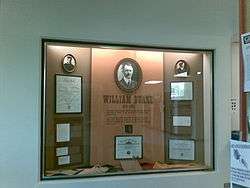William Duane (physicist)
| William Duane | |
|---|---|
| Born |
February 17, 1872 Philadelphia, Pennsylvania, U.S. |
| Died |
March 7, 1935 (aged 63) Devon, Pennsylvania, U.S. |
| Nationality | United States |
| Alma mater | Berlin University |
| Known for |
Duane-Hunt law Duane's hypothesis |
| Awards | Comstock Prize in Physics (1923) |
| Scientific career | |
| Fields | Physics |
| Institutions | Harvard University |
| Doctoral advisor | Walther Nernst |
| Influences | Madame Curie |
| Influenced | Alfred Landé |
William Duane (February 17, 1872 – March 7, 1935) was an American physicist. A coworker of Marie Curie, he developed a method for generating quantities of radon in the laboratory.
Biography

Display about Duane at the University of Colorado Boulder
Studies
- 1888-1892 University of Pennsylvania
- 1892-1895 Harvard University
- 1895 Universities of Göttingen (as a Tyndall Fellow)
- 1895-1897 Berlin
doctor father: Max Planck
Academic career
- 1898-1907 professor at the University of Colorado Boulder
- 1908-1913 at the laboratory of Pierre and Marie Curie in Paris
- 1913-1917 assistant professor of physics at Harvard University
- 1917-1934 professor of biophysics at Harvard University
Research activities
- Radioactivity
- X-ray spectroscopy, Duane-Hunt law, relating the minimum wavelength of X-rays to the threshold voltage of the cathode rays that excite them; and Duane's hypothesis of quantized translative momentum transfer.
Death
Starting in 1925, Duane began suffering a continual decline in health brought on by diabetes. This culminated in his death on 7 March 1935 due to his second paralytic stroke.
Honours and awards
The physics department building in the University of Colorado Boulder is named after him. In 1923 Duane was awarded the Comstock Prize in Physics from the National Academy of Sciences.[1]
References
- ↑ "Comstock Prize in Physics". National Academy of Sciences. Retrieved 13 February 2011.
External links
- Biography/Bibliography by Nobel Laureate P.W. Bridgman
- Britannica article on Duane-Hunt law
- Duane's "Radon Cow" described
- The Birth of Nuclear Medicine Instrumentation: Blumgart and Yens, 1925 -- Patton 44 (8): 1362 -- The Journal of Nuclear Medicine
- Outline of history of nuclear medicine
- The Transfer in Quanta of Radiation Momentum to Matter -- Duane 9 (5): 158 -- Proceedings of the National Academy of Sciences
- Discussion of Duane's quantum theory of diffraction in History of Twentieth-Century Philosophy of Science by Thomas J. Hickey with free downloads
This article is issued from
Wikipedia.
The text is licensed under Creative Commons - Attribution - Sharealike.
Additional terms may apply for the media files.